Water Level Monitoring System
(Updated: August, 2021)
The Amazon bubbler from YSI is our most robust and reliable bubbler, and we want to ensure that customers realize all the benefits of this best-in-class technology for measuring water level (Figure 1). In case you’re new to the Amazon bubbler, a brief background is provided to describe its features. Alternatively, you might prefer to scroll to the section regarding optimizing the use of the Amazon in the field.
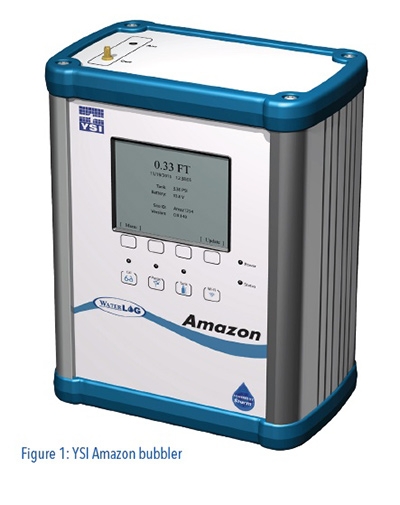
Bubbler Background
The principle underlying bubbler technologies is very straightforward: by providing a continuous flow of gas bubbles into the water, the pressure required to maintain a continuous calculated bubble rate is used to determine the depth of the water. Historically this was done with an external pressure sensor that was in line with a nitrogen tank, but there were several disadvantages to these original systems: the nitrogen tank had to be refilled or replaced, a manual purge of the bubble line was required to get set up, and manual adjustments had to be made to set the bubble rate. These disadvantages translated to downtime, data loss, and more labor required to maintain the system.
There have been several evolutionary stages of the technology since the 1990s. The Amazon certainly represents the most evolved bubbler technology, and some of its key physical features include:
- A compressor and small holding tank replace the nitrogen tank.
- An integral pressure sensor, enabling greater accuracy of measurement.
- A microprocessor-controlled “smart” gas system, which synchronizes gas purges with measurements, so that measurements are not disrupted during operation.
- Battery operation for low power consumption.
The features outlined ultimately translate to the most compact, reliable, and accurate bubbler technology available. Other features that make the Amazon exceptional are related to the user interface and data acquisition features, especially:
- Optional “paper-white” display for ease of programming (Figure 2).
- Internal data logging, with data recovery via a USB flash drive or a PC (Figure 2).
- The ability to communicate with any data logger via SDI-12 or 4-20 mA (Figure 3).
- Communication with a PLC via Modbus over RS-485 and Ethernet
- A web interface that leverages wireless connection via a web browser, enabling simple site calibration and maintenance.
Additionally, the Amazon is extremely rugged for use in harsh environments. Its one-piece manifold eliminates many potential sources of leaks, and it is designed and rated for extreme temperature operation (-40°C to +60°C).
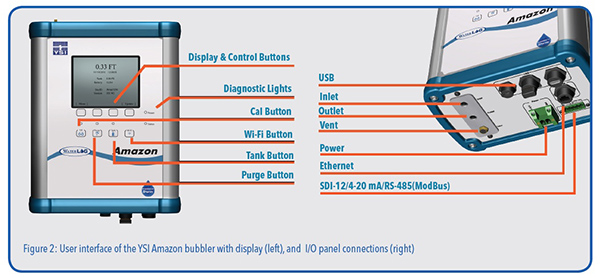
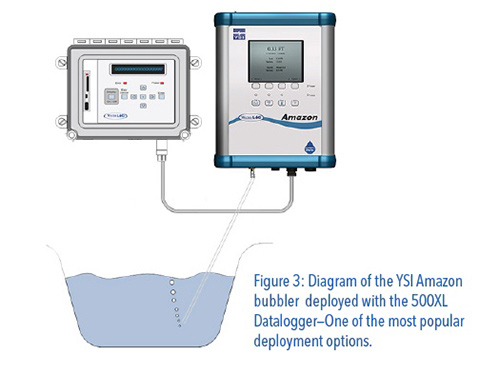
As this is clearly the best bubbler available, let’s discuss how to ensure you get the best use of it in the field.
Optimizing Field Performance
For the most accurate water level measurement, as well as ensuring the longest operational life of your bubbler, the following three items should be taken under consideration:
- Utilizing the dry air system and maintaining your desiccant
- Proper installation of the orifice line.
- Working with the Amazon’s built-in averaging feature to improve data quality.
Dry Air System
It is imperative to use the dry air system, which consists of a desiccator containing desiccant (Figure 4). The Amazon is a sealed system and only draws air in through its inlet. This dry air system removes any moisture that might be in the air. If moisture makes its way into the bubbler, it travels the same path as the air used to create the bubbles, and that moisture can compromise your bubbler in two ways.
First, the Amazon has several electronic valves that open and close during a measurement. If exposed to moisture the valves will start to corrode and they will not switch correctly. The result is your measurements will become erratic. To repair this type of damage the unit has to be sent into our repair center.
Second, moisture in the system can partially block or even fully block internal airways before the bubble enters the orifice line reducing or preventing bubbling. A unit in this situation likewise has to be returned to YSI for repair.
The easy way to avoid these problems is to simply use the desiccator and maintain your desiccant. Dry desiccant is blue, wet desiccant is pink. You’ll know its time to change your desiccant as it changes color from blue to pink. Doing this will give your Amazon a long and productive life, and will save you money.
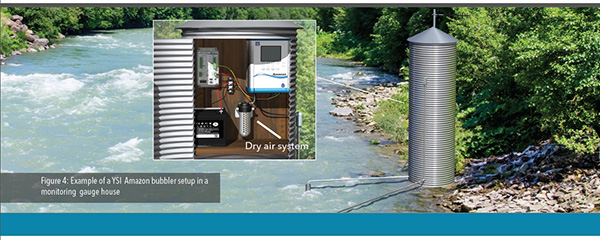
Figure 4: Example of a YSI Amazon bubbler setup in a monitoring gauge house.
Orifice Line Installation
The orifice line is the bubble delivery system. It is the pathway that allows the bubble to leave the bubbler and ultimately exit into the water. For the highest quality data from your bubbler, the following best practices should be observed as much as possible for your environment.
1) Mount the outlet in still water. Avoid mounting the orifice outlet in the wake of an obstruction, bridge peer, rock, etc., or in any area of turbulent flow.
2) Mount the outlet so that the last inch or so is 25° of horizontal. This angle will yield a slightly downward facing exit for the bubble and help to maintain the calibrated bubble rate (Figure 5).
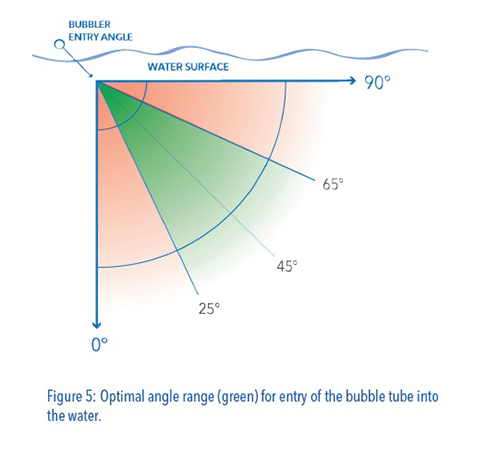
3) The orifice line outlet should be mounted perpendicular to the bank and “slightly” downstream. Do NOT mount the orifice outlet facing upstream bubbling into the current or fully downstream bubbling with the current.
4) Mount the orifice line so that the exit is the lowest point. There should be a continuous downward slope from the bubbler to the exit. Dips and coils in the orifice line collect moisture and will affect the way the bubble travels through the orifice line and ultimately show up in your data (Figure 6).
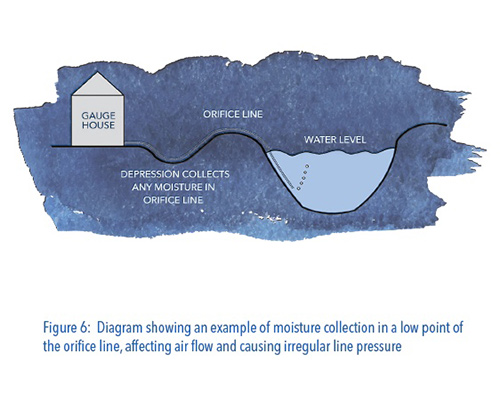
5) Protect your orifice line in some type of conduit and secure the exit. A non-secured orifice line exit is allowed to move around and any movement will compromise your measurements and will be directly related to noise in the data. We recommend using a 2” galvanized pipe along with our H-253 Orifice Kit (Figure 7). The orifice kit is a very simple package of items that enable one to pass the bubble tube through a fixed pipe to which the kit’s threaded bulkhead will be attached to the submerged end. If the pipe is secure so is the orifice line exit. This is a very clean and easy way to secure your orifice line exit.
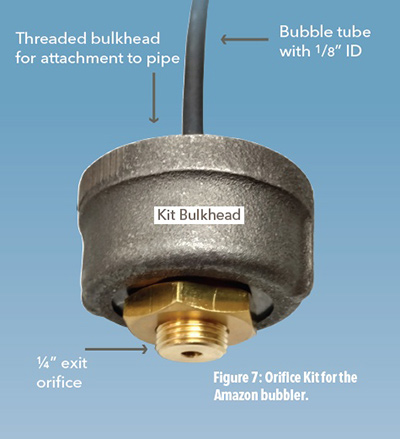
Following these recommendations will lead you to a successful installation and high-quality data. As discussed below, the averaging feature will be one of the most important things you can use to also ensure data quality.
Averaging
There are situations where we’ve observed the practices listed above, but events out of our control cause noise in the data. For example, wave action from tides, storms, and even boaters and recreational activities can introduce noise into the data. The Amazon has built-in averaging that helps to clean up noise in the data, and it is a menu option that is easily selected by the user. Consider the case where a wave can affect your data. It is best to measure for a time period of 3 wave cycles and to average the measurements over that period. Waves that are 5 seconds apart, would then lead to an averaging time of at least 15 seconds. Of course, you never know the exact periodicity of a wave event that might arise, but in general, waves caused by boats are only a second or two apart, so averaging for 3-6 seconds can greatly improve data quality. In extreme conditions where averaging isn’t sufficient to reduce noise, you might reduce the bubble rate.
The bubble rate affects the bubbler's ability to track water level change. By reducing the bubble rate you essentially slow the bubbler’s response to level change (Table 1). A word of caution: the factory set 60 bubbles/min is, in most cases, sufficient for accurately measuring water level, and we generally don’t recommend straying from that setting. Even in the scenarios where water level might change rapidly (e.g., a stormwater ditch or flood catchment), we recommend that users work at that default rate initially and utilize the Amazon’s averaging until their data suggest that fine-tuning the bubble rate might improve data quality. Only in rare circumstances should you need to adjust your bubble rate.
Table 1: Approximate time the Amazon needs to respond to accurately track a one foot rise in water level.
| Bubble Rate (bubbles/min) |
Response (seconds) |
| 30 |
25 |
| 60 |
20 |
| 120 |
15 |
In summary, using and maintaining your dry air system, properly installing the orifice line, and using Amazon features will give you the best data and the longest lifetime for your bubbler.
Additional Blog Posts of Interest
Benefits of Using a Bubbler to Measure Water Level
How to Keep Interferences from Affecting Your Water Level Data